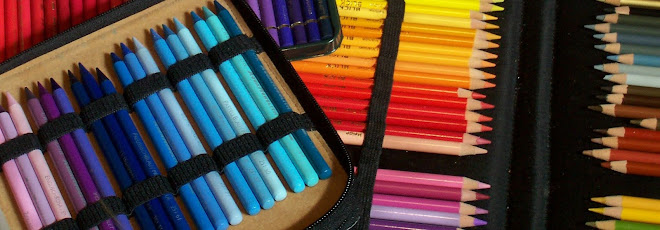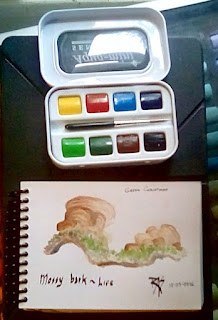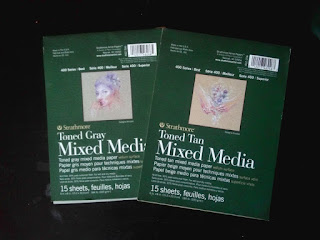Common Morpho Butterfly painted in Finetec Pearlescent Colors on Fabriano Black Black Mixed Media Paper.
Wow. Someone's come out with black watercolor paper, for painting in gouache, acrylic and other opaque water media. Don't be fooled by the name. This stuff is 300gsm or about like 140lb watercolor paper, not the usual 90lb mixed media paper. It is a good strong heavy paper that doesn't cockle. There's also a White White pad with the same paper but I didn't buy it, since I have plenty of white watercolor paper and nuances on bright white would not be as important as the first actual black watercolor paper I've got to work with. Fully sized with a nice soft cold press texture, this stuff is gorgeous. It's heavy, sturdy and dark.
Till now my favorite black paper has been black Stonehenge paper, which is still my favorite colored pencils paper. But when I'm bringing in wet media, Fabriano Black Black is well worth it. It's toothy for use with aquarell pencils. I sketched under my Common Morpho Butterfly with my Caran d'Ache aquarell pencils and got beautiful heavy color. The white helped me lighten a couple of areas and strengthened the white dots under the pearlescent white.
My next delight was finding out how well those Finetec Pearlescent Colors work on black. They are good and bright! Add enough and they're opaque. They're actually pretty easily opaque, a touch more opaque than the Daniel Smith Luminescent watercolors that are my other favorites. They're in pan form rather than tubes and individual colors can be ordered if all you need is a good gold for decorating a medieval scroll or something.
SCA scribes, this is very convenient gold or silver in a pan to tuck into your scribe kit for illumination. There's also a six color set that's hues of gold, copper and silver which can work well for scribes, but if all you need is one gold, look for Olympic Gold, I think that's the one that's the closest match to shell gold - the real gold dot that's powdered gold in gum arabic.
The six color Iridescent Set looks to be what Daniel Smith labels Interference Colors - pale with a soft hint of color that changes to its complement when tilted. These are using simila pigments - mica treated and ground to produce shimmering iridescent color. The effects are spectacular. Mystic Color in the 12 Color Pearlescent Set is also an interference color, bouncing between a red and a blue green. It's beautiful and dark, unlike the other interference colors. It's very handy for when I want that effect in lower value areas.
Finetec are artist's mica pigment colors. They're lightfast and high quality, artist grade, I'd have no trouble selling paintings done with them whether that's in combination with other water mediums or by themselves. The form is actually even handier for me because I dislike carrying tubes around but do like painting with friends and some things like an iridescent effect - the Mystic color would be particularly effective on the necks of grackles and pigeons.
Opaque colors can be thinned to light washes just by adding more water. They work very well painted over similar flat hues for a subtle effect. I've often used a thin glaze of blue or aqua over a reef scene and found the iridescence vanishes - thin enough it doesn't really change the hue of non-blue objects like fish or corals, but does give a richness to the water and sense of luminous water that wasn't there without it. Mica paints aren't just for glitz and glitter.
But they are fun for that too. Any holiday cards or other projects you want to jazz up with shimmering iridescence will benefit from Finetec Pearlescent Colors and Iridescent Colors. Those can be very good on snow scenes in a thin glaze over the entire snow area, since snow has that kind of effect too. Mix a little in with the shadow colors or use it to create slight tints for atmospheric recession - bluish cast in the distance, rosy in the mid values shading up through to thinnest gold or yellow.
Price is reasonable for artist grade materials, but not in the bargain range for the Finetec colors. They are available at many outlets online including Dick Blick and some of the calligraphy and pens places, because they are so good for embellishing. A friend picked one up from a brick and mortar store too, they're not hard to find. Definitely give them a try. Blick has them in open stock if you want to try just one color first or all you need is scribal gold. That open stock is also convenient since the tin for the 12 color pans may wind up wearing down unevenly, depending on your style and favorite colors. Some colors run out faster than others by area of the painting.
There is a very nice, subtle iridescent black in the 12 colors set too. It's deep dark, it will vanish on black paper to anything but close inspection.
Fabriano Black Black and White White paper comes in two pad sizes, 8" square and 9 1/2" x 12 3/4" - good convenient sizes. I don't know if it's available in full sheets since I got the larger pad, but it's great stuff and I know I'll use it often. Of course you can also combine these things with a brush or dip pen to do gold and colorful calligraphy on black paper too, to make striking cards!
EDIT: Note to Readers - the entry for the 7th was going to be the Pebeo Masking Marker, which I was all excited about getting. It arrived yesterday. The project is set up to paint with it. Unfortunately, what I found out is that if it got frozen along the way it becomes useless. Blick is replacing it, so hopefully I'll be able to review a working one next week!
EDIT: Note to Readers - the entry for the 7th was going to be the Pebeo Masking Marker, which I was all excited about getting. It arrived yesterday. The project is set up to paint with it. Unfortunately, what I found out is that if it got frozen along the way it becomes useless. Blick is replacing it, so hopefully I'll be able to review a working one next week!





















